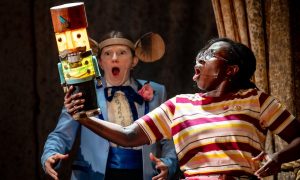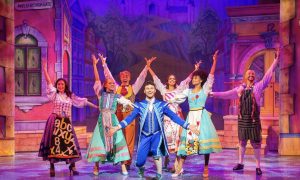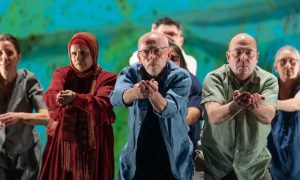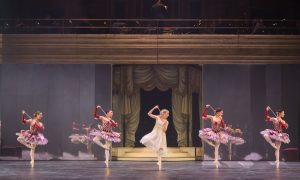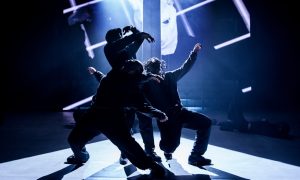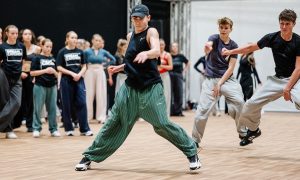Lilian Baylis Studio, Sadler’s Wells Theatre, London.
13 September 2025.
‘Capturing the quiet force and enduring beauty of Asian cultures,’ read the intriguing pre-performance note and seated in the small comfortable theatre with plenty of legroom – not always the case in theatres! – we are welcomed by Festival Director Simon Hodgkinson to Concrete Rain, the first Asian Dance Festival. A one-day celebration bringing together emerging East Asian choreographers.
First onto the stage is Neverland Space Theatre, presenting Towards a New Architecture: Brutalism. In loose individual clothing, dancers had sombre expressions and beat time with bare feet while moving shapes were projected onto the cyc. There were some quite mesmerising moments in the soundtrack, including a repeated whispering male voice. The small group gave way to a close and impassioned duet; the two dancers maintaining connection without eye contact, giving them an individual feel at the same time as togetherness. The intimate dialogue between architect and creation was explored and the piece came to a close with soft, individual movements, surrounding and supporting the lead dancer.
Entitled Invisible Chaos by choreographer and dancer Tomo Sone, this lengthy solo – an emotive piece, that was rich in gesture but sometimes uncontrolled in balance and extension, came next. A still and respectful audience watched, and there was a diverse soundtrack with different sounds and sections to it. I enjoyed the natural bare foot work; an opportunity to observe the way the dancer moved stylistically quite flatfooted through the dance, which did have impact on weight placement and alignment.
In The Great Void performed by Dove Che, Qi Song and Yos Clark, we first saw entwined hands with long black fingernails in a spotlight; followed by an entwined male/female couple, in natural coloured foundation garments, twisting arms and torsos around one another, with a mystical female voice singing as they rocked. It was quite restful to watch. They moved using their body weight against each other, unhurried, sensual shapes and locomotion during this exploration between reality and illusion, rooted in the meditative depths of Eastern philosophy.
Double-Edged: Laboratory of Human Friction followed in dramatic contrast. Performed by London-based artists Ka Ki Christina Lai and Ying-Yen Yvonne Wang, they opened with tension, tussling with one another, spoken word their soundtrack. The initial intensity lessened as they parted. One dancer mimicked the other and tried to initiate connection; one more interested in a relationship than the other in this experiment of two contrasting personalities colliding, negotiating and transforming. This was very visually appealing physical theatre. Impactful and relatable.
I greatly appreciated the sentiment of the last piece before the interval. Dancers in loose black clothing in Sayonara by Unboxing Theatre entered carrying sticks that formed a coffin, the walking body of a person, a fire, and finally remembrance of a loved one as they reverently carried them off stage at the end. Sayonara was intended as a reflection of the tension between public ceremony and private emotion, asking; how do we say goodbye? An emotive piece drawing on East Asian funeral traditions.
The second act opened with a short film on the cyc – a girl with arms wide on a breezy hillside. Onstage, dancer and choreographer Kiwi Chan wore a sheep’s head mask and the shoulder girdle of a skeleton round her neck. She used stylised movement as the film rolled. Movements echoed but perhaps intentionally were not in synchronisation with the girl on the film who was also dancing. An interesting idea, with more development possible, about ‘the spell of unconditional love, and breaking through by dancing with an unburied skeleton as though this is herself, her mum, her mum’s mum…..’
Face hidden by a fan and balletic physique immediately apparent, a dancer in white top and loose red shorts entered to a clock-like beat. Her partner, dressed identically followed and Yerim Kim and Hahyun Kim performed a well-matched duet with enjoyable rhythmical interpretation and expressive use of their traditional fans, used as extensions of the body. The fan evokes nature, enhances gesture and bridges cultures – where tradition meets contemporary movement in this piece entitled ‘Chum’, which takes its name from the Korean word for dance.
Finally, When the Petals Fall choreographed by Yan Yin Yung was performed by six dancers in various white flowing clothes. This study of the mythic underworld of Chinese folklore showed dancers caught in the echo between worlds, mirroring the emotional terrain of immigration, its disorientation, silence and aching transformation. A very effective opening where dancers used their own breath, footsteps, and cries to create their own soundtrack. A loud scream silenced them and then side-lighting and a low background hum saw them begin to move slowly, heavily as though being pulled. There were plenty of mini duets and solos in and amongst the group dance, which used both stillness and chaotic repetition, a feeling of both fight and support underlying throughout.
All acts in this very diverse festival returned to the stage for bows and applause.
By Louise Ryrie of Dance Informa.



